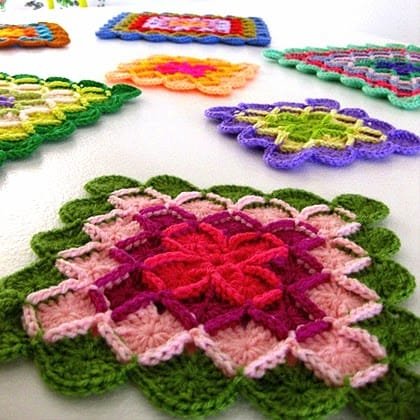Welcome to our Crocheted Wool-Eater Blanket – Tutorial! In this article, we will guide you through the steps to create a beautiful and cozy wool-eater blanket that is perfect for adding warmth and charm to any space in your home.
This delightful project is not only a great way to practice your crochet skills but also a fantastic way to create a unique and personalized blanket for yourself or as a thoughtful gift. The Crocheted Wool-Eater Blanket uses a stunning stitch pattern that creates a textured and visually appealing design, making it a perfect addition to your crochet repertoire.
Crocheting a wool-eater blanket can seem daunting at first, but fear not! With clear instructions and a bit of practice, you’ll find that this project is both enjoyable and rewarding.

This blanket is ideal for beginners and experienced crocheters alike, as it allows you to experiment with colors and yarn types. You can mix and match to create a custom piece that reflects your style. We’ll cover everything from selecting materials to the finishing touches in this comprehensive tutorial.
Before diving into the actual crocheting, it’s essential to familiarize yourself with the techniques and patterns involved. The wool-eater stitch is not only eye-catching but also offers an excellent opportunity to learn new skills.
So grab your yarn and hooks, and let’s get started on your Crocheted Wool-Eater Blanket adventure!
1. Materials Needed
Before you begin your Crocheted Wool-Eater Blanket – Tutorial, it’s crucial to gather all the necessary materials. Having everything ready will make your crocheting experience smoother and more enjoyable. Here’s a list of items you’ll need to get started:
- Yarn: Choose a medium-weight yarn (worsted weight) for your blanket. You can use 100% wool or a wool blend for a cozy feel, or opt for acrylic yarn for ease of care. Select multiple colors to create the classic wool-eater pattern, which typically combines a main color with contrasting shades.
- Crochet Hook: A size H (5.0 mm) or I (5.5 mm) crochet hook works well for worsted weight yarn. Ensure your hook size matches the yarn label for optimal results. A comfortable hook will help reduce strain on your hands during the crocheting process.
- Scissors: A sharp pair of scissors is necessary for cutting your yarn at the end of each piece. Keeping a dedicated pair of crafting scissors will make this task much easier.
- Tapestry Needle: A tapestry needle is essential for weaving in loose ends and sewing any pieces together. Choose one with a large enough eye to accommodate your yarn.
- Measuring Tape: Measuring tape will help you keep track of the blanket’s dimensions as you crochet. This is especially important if you want to achieve a specific size for your finished piece.
- Stitch Markers: Stitch markers can be helpful in keeping track of your stitch counts and marking the beginning of each round. This is particularly useful for beginners who may lose their place in the pattern.
2. Understanding the Wool-Eater Stitch
The wool-eater stitch is the heart of your Crocheted Wool-Eater Blanket. It creates a beautiful, textured design that resembles small squares, making it visually appealing and perfect for blankets. Understanding this stitch is essential for completing your blanket successfully. Here’s a breakdown of the wool-eater stitch:
- Foundation Row: To start the wool-eater stitch, you will create a foundation chain. The number of chains should be a multiple of 3, plus an additional 2 chains to turn. This foundation will serve as the base for your blanket.
- First Row: In the first row, you will alternate between single crochets and double crochets, which create the distinctive pattern. This row sets the tone for the entire blanket, so make sure to follow the pattern closely.
- Subsequent Rows: The subsequent rows will build upon the foundation you created. Each row will consist of repeating the wool-eater stitch pattern, which involves increasing and decreasing stitches to achieve the desired texture.
- Color Changes: One of the beautiful aspects of the wool-eater stitch is its adaptability to color changes. You can easily switch colors between rows to create a stunning visual effect. When changing colors, make sure to leave a long tail to weave in later.
- Consistency: Maintaining consistent tension while crocheting is essential for achieving a uniform appearance. Practice makes perfect, so don’t hesitate to rip out stitches and try again if you feel the tension isn’t right.
- Practice: Before diving into your blanket, it can be helpful to practice the wool-eater stitch on a smaller swatch. This will allow you to familiarize yourself with the pattern and make adjustments as needed.
3. Crocheting the Blanket
Now that you understand the materials and the wool-eater stitch, it’s time to start crocheting your Crocheted Wool-Eater Blanket! Here’s a step-by-step guide to help you along the way:
- Start with a Foundation Chain: Create a foundation chain that is a multiple of 3 plus 2 additional chains. For example, if you want your blanket to be about 50 inches wide, you may chain 152 (50 = 3*50 + 2).
- Begin Row 1: In the second chain from the hook, work a single crochet. Then, in the next chain, work a double crochet. Alternate between single and double crochet stitches across the row until you reach the end.
- Transition to Row 2: For the second row, turn your work and chain 2. This will act as your first double crochet stitch for the row. Then, work the wool-eater stitch pattern as established in the first row.
- Repeat the Pattern: Continue crocheting each row, following the wool-eater stitch pattern. You’ll see the squares start to form beautifully as you work your way through the rows.
- Color Changes: When you reach the end of a row and wish to change colors, simply finish the last stitch of the current color and pull through the new color for the last loop. Cut the previous color and weave in the ends later.
- Keep Track of Your Progress: Use a stitch marker to mark the beginning of each row. This will help you keep track of your progress and maintain an even number of rows throughout your blanket.
4. Finishing Touches and Care Instructions
Once you’ve completed your Crocheted Wool-Eater Blanket, it’s time for the finishing touches. These steps will enhance the overall appearance and longevity of your blanket:
- Weaving in Ends: After you finish crocheting, take the tapestry needle to weave in any loose ends from color changes or starting new yarn. This step is crucial for creating a polished look and preventing unraveling.
- Blocking: Blocking your blanket will help shape it and even out the stitches. You can gently wet your blanket and lay it flat to dry, pinning it into the desired shape. This step is optional but can improve the appearance significantly.
- Care Instructions: If you used wool yarn, consider hand-washing your blanket in cool water with a gentle detergent. Acrylic yarn can typically be machine washed on a gentle cycle. Always check the yarn label for specific care instructions.
- Storing Your Blanket: When not in use, store your blanket in a cool, dry place. Avoid direct sunlight to prevent fading. If you need to fold it, do so loosely to maintain its shape.
- Gifting: If you plan to give your Crocheted Wool-Eater Blanket as a gift, consider adding a personalized note or care instructions. This small gesture can make your handmade gift even more special.
- Enjoying Your Blanket: Finally, snuggle up with your cozy creation! Whether you’re using it on the couch, as a throw for your bed, or a decorative piece, enjoy the warmth and beauty of your handmade Crocheted Wool-Eater Blanket.
FAQ
1. What is a wool-eater blanket?
A wool-eater blanket is a crochet project characterized by its unique stitch pattern that creates textured squares. It’s often made with wool or wool-blend yarn for added warmth.
2. How long does it take to make a wool-eater blanket?
The time it takes to complete a Crocheted Wool-Eater Blanket varies based on your skill level and the size of the blanket. It can take anywhere from a few days to a couple of weeks.
3. What yarn is best for a wool-eater blanket?
Medium-weight yarn, such as worsted weight wool or a wool blend, is ideal for a Crocheted Wool-Eater Blanket. You can also use acrylic yarn for a more affordable option.
4. Can I use different colors for my blanket?
Absolutely! The wool-eater stitch is perfect for incorporating multiple colors. You can create stripes, gradients, or any design that appeals to you.
5. Is this tutorial suitable for beginners?
Yes! This Crocheted Wool-Eater Blanket – Tutorial is designed for beginners and experienced crocheters alike. The stitch pattern is easy to learn with practice.
6. How do I care for my wool-eater blanket?
Care instructions depend on the yarn used. Wool yarn should be hand-washed in cool water, while acrylic yarn can typically be machine washed on a gentle cycle. Always refer to the yarn label for specific care details.
Join our VIP broadcast list and gain access to exclusive patterns, all for free. As a VIP member, you’ll receive the best patterns daily, delivered directly to your device. ✨📱 It’s a unique opportunity to stay up-to-date with the latest trends and designs, curated just for you. Don’t miss out on enhancing your projects and discovering new inspirations with the best patterns every day! 🎨🔝
Conclusion
In this Crocheted Wool-Eater Blanket – Tutorial, we have covered everything from materials to the intricate wool-eater stitch, finishing touches, and care instructions. By following the steps outlined in this guide, you’ll be well on your way to creating a stunning, cozy blanket that showcases your crochet skills. Whether you keep it for yourself or gift it to someone special, your wool-eater blanket will surely be cherished for years to come.
We’d love to hear your thoughts! Please leave your honest feedback and any suggestions you may have in the comments below. Happy crocheting!




